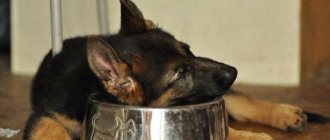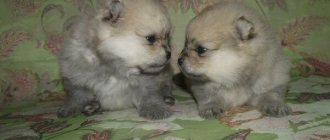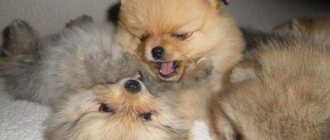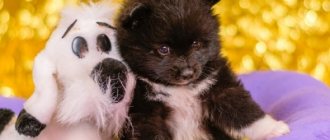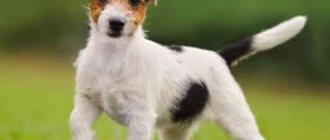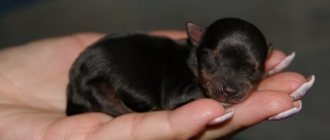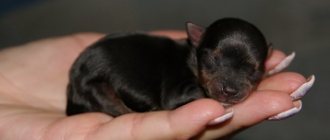The Toy Terrier is a small, cute and very active dog that belongs to the decorative breeds.
Such pets are easy to train.
They are very friendly.
As a rule, they find a common language with both family members and other animals.
Toy terriers are one of the breeds of dogs with which it is allowed to enter public transport and stay in hotels.
Photos of what newborn puppies look like
Immediately after birth, toy terrier babies are almost completely helpless; the only thing they can do is reach their mother’s nipple, actively suck and squeak.
Newborn Toys are blind, deaf, and cannot defecate on their own . Their mother helps them with this. She carefully licks the babies and eats the secretions.
Among other things, immediately after birth, toy terrier puppies lack normal thermoregulation, so they are completely dependent on external sources of heat.
The size of a newborn toy terrier is smaller than a woman's palm and resembles a newborn kitten.
How much does a Russian Toy Terrier cost?
You can buy a Russian Toy Terrier puppy in nurseries for 20,000 – 50,000 rubles. Cheaper options can be found in the advertisements. In this case, the price of an animal with the RKF metric will be from 12,000 to 17,000 rubles. In addition, the cost is affected by the class, gender and color of the dog. Although the sexual type of Russian Toys is weakly expressed and the external characteristics of males and females are approximately the same, the latter will cost significantly more. Of the entire palette of colors, lilac-tan and blue-tan are considered the most scarce and, accordingly, expensive. The cheapest color option is red.
How does it develop day by day in the first month?
| Days | Physical development and behavior change |
| 1-4 | The puppy cannot see or hear, he has no fat layer, and thermoregulation is undeveloped. During this period, the puppy produces meconium (original feces). |
| 5 | Pain sensitivity is reduced, the brain is poorly developed. |
| 6-8 | The nose becomes stained, reflexive chills appear, and active weight gain occurs. |
| 8-9 | The original weight is doubled. |
| 10-15 | The puppy's eyes begin to open, the pupil reacts to light, but the retina is poorly developed. |
| 16-18 | A fat layer begins to form, thermoregulation improves, and the puppy gradually learns to cope without additional sources of heating. |
| 19-21 | The toy terrier baby begins to hear and reacts to sound. |
| 22 | Baby teeth begin to emerge. |
| 23-24 | The sucking reflex fades, interest in solid food appears. The puppy already knows how to bite, chew, and is actively exploring the world. |
| 25-30 | Thermoregulation is fully formed, the body temperature is like that of an adult, the baby is already responding to its name, and motor activity is increasing. |
Reviews
Katya, Samara: “We adopted a short-haired Toy as a puppy from a nursery a year ago. Nice baby. Eats well, playful, affectionate. We have never regretted it yet. The whole family loves him."
Natalya, Minsk: “They gave me a toy for my birthday. I was even confused when I saw the puppy. I can now say that it was the best surprise of my life. Cool, handsome toy terrier boy.”
Victor. Kaluga: “My mother also has a black and white one. She dotes on him. Sometimes it seems that the dog is more valuable to her than everyone else. He carries his terrier with him everywhere. And if he leaves, then he will call 10 times a day and ask about the dog.”
How does it develop from 1 to 12 months?
Development of a toy terrier puppy from 1 month to 1 year:
| Age (months) | Description | Size(cm) | Weight (g) |
| 1 | Newborn period. The puppy knows how to suck the mother's nipple and move its paws to get to it. The baby does not have independent thermoregulation, he does not know how to empty himself. | 6-10 | 200-650 |
| 2 | Transition period. At this age, the puppy has already opened his eyes and began to hear, is able to move independently and play, and a craving for solid food appears. Baby teeth have already appeared. | 10-14 | 320-1050 |
| 3 | Period of socialization. By this age, the puppy has already formed the basic functions of the body, active growth and weight gain continue. A daily rhythm begins to form and physical activity increases. During this period, the dog begins to understand the “laws of hierarchies.” | 14-20 | 460-1550 |
| 4 | Teeth change and the immune system begins to form. Until this age, the puppy’s immunity functioned due to beneficial substances obtained from the mother’s milk. | 18-24 | 600-1900 |
| 5-6 | Juvenile period. At this time, the puppies develop their character. Individual qualities and specific behavioral reactions. At this age, the first sexual games begin. | 20-28 | 700-2200 |
| 7 | Puberty. During this period, the Toy Terrier bitches’ eggs begin to mature and they become capable of fertilization. At the same age, the first estrus begins. | 20-28 | 800-2500 |
| 8-12 | Period of puberty. | Growth is over | Weight gain stops |
Dog appearance (standards)
Dimensions
An adult dog weighing 3 kg has a height of 20 to 28 cm. Deviations in height varying within 1 cm are acceptable.
There is a mini toy terrier whose height does not exceed 20 cm and weighs no more than 1.5 kg.
Wool
Russian Toy can be short-haired or long-haired. The first variety is distinguished by the presence of short hair and a complete absence of undercoat. The dog's coat, which does not have bald patches, lies tightly to the body. Long-haired dogs are characterized by having an elongated coat that can be either straight or slightly wavy. A feature of these dogs is longer hair on their paws, tail and ears.
Photo: https://pixabay.com/photos/dog-toy-terrier-small-pets-view-2911679/
Colors
The characteristics of the breed include the following colors: brown and black and tan, lilac and tan, red and black, fawn, chocolate, blue and tan, cream, any shades of red.
Solid white, brown and black are not acceptable. The only acceptable color of the English Toy Terrier, unlike the Russian, is black and tan.
Head
The head, small compared to the body, has an elegant shape. It is dry and moderately wide in the cheekbone area.
Teeth and jaws
Small teeth stand out white. The dog has a scissor bite.
Eyes
The eyes are round, large, slightly protruding. Planted quite wide and straight, the main color is dark.
Body and limbs
The dog's loin is short, its chest is oval and deep, and its belly is tucked. The croup is slightly sloping.
The forelegs are straight and parallel, rather dry. The hindquarters are also straight and parallel, but set a little wider. The thighs are dry and muscular.
Tail
The tail is usually docked, leaving only 2-3 vertebrae. In countries where docking is prohibited by law, the tail remains natural and crescent-shaped.
Photo: https://www.flickr.com/photos/highlander411/7953263890/
Rock defects
The following deviations are considered defects:
- straight bite;
- lack of a large number of teeth;
- drooping ears;
- the presence of bald patches in smooth-haired breeds;
- Long-haired animals lack longer hair on their ears;
- white color or many white spots on the animal’s body;
- height exceeding 30 cm;
- very short height, below 18 cm;
- weight less than 1 kg;
- male cryptorchidism;
- aggressiveness;
- cowardice.
How to care?
In order for a toy terrier puppy to grow up healthy and strong, it is necessary to follow many rules when caring for it, especially in the first year of life.
What do we have to do:
- Feed correctly, and this applies to the diet and the quality of feed (if you give feed), and the amount of food.
- Be sure to ensure that the dog does not get injured, as this often happens to toy terriers due to their diminutive size and fragile bones. Don't let your puppy jump from heights or start fights with other animals.
- Remove all dangerous objects (cables, glass vases, heavy and unstable objects, household chemicals) away. All this should not be within the dog’s access area.
- Make it a habit to inspect and clean your puppy's eyes and ears daily.
- Be sure to give your pet multivitamins containing calcium and phosphorus. This is especially necessary for the baby during the period of changing teeth and setting ears.
- Never feed your dog from your plate.
- Don't let your puppy get too cold or overheated.
- Approximately once every 3 months, give her anthelmintic drugs.
- In the warm season, the dog should be treated against fleas, ticks and other parasites with special compounds.
- Take the time to find a good veterinarian who can provide immediate assistance if necessary. But remember, the chosen specialist must understand the characteristics of the breed.
- Take your pet for walks regularly, he simply needs it, because toy terriers are very active and mobile.
- Be sure to toilet train your puppy and don’t let him relieve himself anywhere, as this will eventually turn into a problem.
- Approximately once every 2-3 months, the toy terrier should be bathed, following all the rules.
- From the very first days of being in your home, accustom your dog to a collar and leash. This is necessary for the safety of the animal.
History of the Russian Toy Terrier breed
Smooth-haired Russian Toy Terrier
The ancestors of Russian Toys were English Toy Terriers, who gained fame as incomparable rat catchers. The first representatives of this venerable family appeared in Russia back in the era of Peter the Great, and by the middle of the 19th century, small but extremely playful dogs turned into the favorite pets of the domestic elite. Toy terriers lived in imperial residences, guarded the chambers of wealthy landowners, traveling to balls and social events with their arrogant mistresses.
With the advent of Soviet power, decorative dogs migrated to the category of “bourgeois excesses”. The new government gave preference to more useful breeds aimed at full-fledged service and protection, so for almost half a century, toy terriers remained in the shadows, gradually dying out and degenerating.
In the 50s, Soviet cynologist enthusiasts decided to revive the tribe of legendary salon dogs. But since there were no purebred representatives of the toy terrier family left in the USSR by that time, specialists had to work with animals without pedigrees and individuals taken by Soviet soldiers from Germany as war trophies. An additional difficulty was that the offspring obtained during the experiment could not be compared with the cubs of English terriers due to the Iron Curtain policy. As a result, domestic experts did not suspect for a long time that they had bred a new breed, significantly different from the one they were initially targeting. For example, toy terriers of the Soviet “spill” were one and a half times smaller than their British counterparts, had different body proportions and skull shape.
Longhaired Russian Toy Terrier
However, the discoveries did not end there. In 1957, in a family of Russian Toys, where one of the parents was not purebred, a male puppy was born with long feathering of fur in the area of the ears and paws. The animal looked so cute and funny that the breeders decided to keep this attractive mutation, leaving the puppy for the breed. This is how an independent branch of the breed appeared - the Moscow Longhaired Toy Terrier.
Despite their sharply increased popularity, Russian Toy Terriers remained “local” pets for quite a long time, practically unknown outside the country. And only in 2006, the International Canine Association, reluctantly and with reservations, recognized salon dogs as an independent breed. At the request of the FCI commission, Russian Toy Terriers were renamed Russian Toys and received the right to participate in world and European championships.
An interesting fact: among the famous owners of these “toy” dogs are Alla Pugacheva, Garik Kharlamov, Sergey Lazarev, Christina Aguilera and Diana Gurtskaya.
What to feed for the first 3 months?
Products necessary for a toy terrier puppy:
- Cottage cheese, kefir, yogurt.
- Boiled egg yolk (once a week).
- Boiled lean beef.
- Boiled chicken.
- Boiled or scalded beef or chicken liver.
- Beef heart.
- Boiled or raw vegetables (cabbage, greens, zucchini, carrots, beets, fruits).
- Premium dry food designed specifically for toy terriers. Food is selected taking into account the age of the dog.
- Porridge (buckwheat, oatmeal, rice, etc.).
Under no circumstances should you give your puppy spicy, salty, smoked foods, or beans..
For more complete information about what can be given to a toy terrier and what cannot, read here.
Photos of colors
The most common colors:
- brown and tan;
- black and tan;
- lilac and tan;
- blue and tan;
- pale yellow;
- red with brown, black or without plaque.
The Russian Toy appreciates black, red, fawn and brown shades. Particular attention is paid to rich colors.
How to feed correctly and how often?
Proper care of a small toy terrier involves 4 meals a day in the first 3 months. Subsequently, the puppy is transferred to 3 meals a day.
For a period of up to 6 months, portions for a toy terrier should be no more than 30 grams . Never overfeed your baby!
After six months, the puppy can be fed like an adult dog, that is, 2 times a day, and the serving size will already be 50 g.
Weekly menu
Monday:
- Breakfast - low-fat cottage cheese or kefir,
- Lunch - buckwheat porridge with boiled liver,
- Dinner - oatmeal with boiled heart.
Tuesday:
- Breakfast - yogurt or cottage cheese.
- Lunch - wheat porridge with boiled chicken.
- Dinner - boiled fish with seaweed.
Wednesday:
- Breakfast - boiled egg with low-fat broth.
- Lunch - boiled beef (not fatty) with carrots.
- Dinner - oatmeal porridge with liver.
Thursday:
- Breakfast: cottage cheese or kefir.
- Lunch - 50 dry food designed specifically for toy terriers.
- Dinner - boiled rice with stewed beets and a piece of chicken.
Friday:
- Breakfast - low-fat chicken broth with boiled carrots.
- Lunch - buckwheat with boiled chicken liver.
- Dinner: yogurt or kefir.
Saturday:
- Breakfast - a piece of boiled fish.
- Lunch - boiled oatmeal with beef.
- Dinner: cottage cheese or kefir.
Sunday:
- Breakfast: yogurt or kefir.
- Lunch: beef liver with rice.
- Dinner - zucchini or cabbage.
Pros and cons of the breed
Advantages of the breed:
- long life expectancy;
- cheerfulness;
- devotion;
- excellent security qualities;
- good looks;
- high intellectual abilities;
- ability to get along well with both adults and children;
- ease of care;
- mobility and activity.
Disadvantages of the breed:
- fragility;
- in the absence of training, prone to excessive barking;
- require regular active walking.
What vaccinations should I get? Vaccination schedule
You should know that the first vaccination for a toy terrier puppy is given no earlier than 2-2.5 months . This vaccination is carried out in two stages with an interval of 7-10 days.
At 6-6.5 months, another increase in BIOVAC is made; it includes weakened bacteria of 18 pathogens. This is why it can be difficult for a dog to tolerate.
21 days after the BIOVAC vaccination, the dog is vaccinated against rabies..
Subsequently, all vaccinations are repeated annually throughout the pet’s life.
Interesting facts from the life of dogs
Animals have existed alongside people for more than 30 thousand years. During all this time, a special relationship has formed between humans and pets. But how much do we know about them?
Interesting facts that not everyone knows:
- Scientists have proven that the intelligence level of our pets corresponds to a two-year-old child.
- Dogs can discern human emotions better than other animals. A quick glance is enough for them to understand joy, sadness or anger. They can empathize and experience the same emotions as the owner.
- The breed's hearing is 10 times better than that of humans, and its sense of smell is 10 thousand.
Everyone has a choice about who to keep as a pet. Some people need exotic animals, ornamental pigs, snakes and other animals. But the dog still remains the leader in this place. A loyal, loving, protective four-legged friend will always be appreciated.
Read also: 10 dogs that are not suitable for children
How to bathe properly?
The puppy can be washed 2 weeks after all vaccinations. But the ideal age is 6 months.
Rules for bathing a toy terrier puppy:
- Bathing should not be too frequent, as this can have a detrimental effect on the baby's skin and coat.
- When bathing, use only special products for dogs (shampoos and conditioners). If the package has instructions on how to dilute the product, be sure to do so.
- When bathing a puppy, place a special mat at the bottom of the bath or container so that the dog’s paws do not move apart.
- The water for swimming should not be 38-39 degrees.
- Before bathing, roll 2 cotton balls and cover the animal’s ear canals with them to prevent water and shampoo from getting there.
- After swimming, exclude all drafts.
- After bathing, dry the puppy with a terry towel and let it dry in a warm place.
Types by coat type (example in photographs)
There are differences between smooth-haired and long-haired toy terriers.:
- Smooth coats have no undercoat. Their fur coat is the same length all over their body. Such dogs have a hard time in the cold season, which is why it is recommended to buy special clothes for them.
- Long-haired dogs also do not have undercoat, but the length of the fur coat varies along the body. There are fringes on the ears and elbows. Also, the hair is elongated throughout the body, and especially in the tail area, on the chest and sometimes on the cheekbones.
The appearance of baby teeth and their cleaning
Like other dogs, the Toy Terrier has 42 teeth. 20 on the upper jaw and 22 on the lower jaw.
IMPORTANT!
Puppies' first teeth begin to appear two weeks after birth.
First, the primary canines erupt, then the premolars, then the incisors, and lastly the molars. At the same time, they appear not one at a time, as in a person, but 6 pieces at once, both on the upper and lower jaw.
By the age of 2 months, 28 baby teeth can already be seen in the baby’s mouth..
At home, you can brush your toy terrier’s teeth using a special brush that will not only clean the teeth, but also massage the gums.
To do this, place the brush on your finger, lift the dog’s upper lip and gently brush the teeth with massaging circular movements. When cleaning, you should only use a special paste for dogs .
The procedure itself is recommended to be carried out 1-2 times a month.
Your puppy's oral hygiene should be given close attention, treated promptly, and bite development should not be missed.
Appearance of puppies
Toy Terrier puppies are born very tiny. At birth, their weight does not exceed 200 g .
In most cases, at about 2 months, you can already understand what color it will grow with, but it is not yet possible to identify any defects.
Their muzzle is not too different from the skull, their ears are small and drooping.
Puppies are born blind, with their tail pressed close to their body . The nose and paw pads are still pink - they will darken over time. The claws are soft. The fur is still very short and does not warm the baby in any way, so it is important that he is always close to his mother.
Is it necessary to dock the tail and when to do it?
In the modern world, standards requiring ear cropping cause a lot of controversy among veterinarians, breeders and dog handlers.
Most foreign shows have already abandoned this standard and accept dogs with undocked tails..
Some went even further and stopped allowing dogs with docked ends into exhibitions.
As a rule, tail docking for a toy terrier puppy is carried out on the 3rd day after birth..
Health and diseases of the Russian Toy
The average Russian Toy Terrier lives from 10 to 15 years, although history has recorded cases where individual representatives of this genus lived to reach their 20th anniversary. The most common diseases of Russian Toys are cataracts, retinal atrophy, subluxation of the patella, and hydrocephalus. Pancreatitis is quite common, resulting from attempts to diversify a dog’s diet with pickles and fatty smoked meats.
Particular danger lies in the fragile thin bones and excessive mobility of the animal, so representatives of this breed are injured easily and often. Some individuals may have a genetic abnormality such as avascular necrosis of the femoral head. Usually the disease leads to lameness of the pet, and if left untreated, to complete atrophy of the hind limbs.
How to train correctly and what commands to teach?
The first thing to remember is that a toy terrier is a dog, not a child, and should be treated as such.
What do we have to do:
- Accustom the puppy to its name.
- Don't let your dog growl at you. Stop this action immediately.
- Under no circumstances should you allow someone to enter the door first, as this is a sign of leadership, and the leader should always be the owner.
- Under no circumstances should you take your dog into your bed. If a decorative dog sleeps in its owner’s bed, it begins to perceive him as an equal.
- Don't spoil your dog. Under no circumstances should you speak kindly to him or console him when the dog growls at you or behaves badly. Otherwise, he will take it as encouragement.
- Try to teach the toy terrier basic commands such as: “Ugh,” “No,” “Place,” “Come.”
Character of the Russian Toy Terrier
Russian Toy with owner
Russian Toy Terriers are pets that can dispel any blues. Active, affectionate and emotional, they are ready to frolic and play pranks all day long. These temperamental kids require a lot of attention and constant “feedback”, so when buying a Russian Toy, prepare for the fact that peace and solitude will forever disappear from your home as soon as the animal crosses its threshold. Representatives of this breed are completely non-aggressive, which does not in the least prevent them from being excellent watchmen, warning with their ringing bark about the arrival of an uninvited (and often invited) guest. Among breeders, Russian Toy Terriers are considered to be very smart and skilled manipulators. If the owner, smitten by the sweet appearance of the pet, gives up, there is no doubt: the animal will find a way to use this loyalty to its advantage.
The specific characteristics of the breed include the psycho-emotional instability of its representatives. Russian Toy Terriers easily get turned on by the slightest rustle and take a long time to calm down. As a rule, excitement is accompanied by increased activity of the animal and prolonged barking. Of the unusual talents of miniature dogs, their amazing memory abilities are of particular interest. In particular, Russian Toi are able to store in their memory events that happened three years ago. Often an animal can remember and identify a person it has met only once.
How to distinguish a boy from a girl?
The easiest way to find out the gender of a newborn toy terrier puppy is to examine the baby's genitals..
Examine the area just below the animal's navel.
A male puppy will have a small protrusion here covered with a tuft of fur . This area is clearly visible, you can't go wrong.
Also, between the hind legs of small males there is another tuft of hair; after 8 weeks of age, the testicles will be located here.
In female puppies, the characteristic tuft of hair is absent, and under the tail there is a small seal in the form of a button . This is the genital slit.
Education and training
Hot temper and mischief are inherent in all toy terriers, but proper upbringing can shape the character of dogs. You shouldn’t think that kids don’t need education, just as much as they do. Indifference will lead to the fact that the pet will certainly develop a “Napoleon complex”, which is expressed in the demand to serve, in causeless and uncontrollable barking and outbursts of aggression.
Initially, it is worth establishing certain rules: do not allow the dog to sleep in the owner’s bed, jump on people and climb on people’s laps, bark for no reason, bite and growl. If a person puts forward reasonable demands and always adheres to them, the education process will go faster. It is imperative to make the animal understand that the owner takes the place of the leader and needs to be obeyed.
Punishment as a method of education usually leads to negative consequences: the dog becomes cowardly or, conversely, angry.
A person should express his displeasure, as well as satisfaction, with intonation. A smart pet will definitely understand everything.
There are usually no difficulties with training the breed; the dogs are very smart and quickly understand what their owner wants from them. The animal remembers basic commands right away and can carry out even more complex ones.
You should try to ensure that the dog follows the command the first time, without expecting repeated repetitions from the person.
It is advisable to carry out the same commands both in the house and on the street. This is done so that the animal develops a strong habit of listening to a person, regardless of where he and his owner are.
Experts say that even a child who has reached the age of 8 can train and raise a toy terrier.
Photo: https://www.flickr.com/photos/highlander411/7957135024/
Active walking will help achieve greater obedience. You can safely leave a pet that has released its energy at home without fear of its inappropriate behavior when alone.
How to choose a puppy?
If you decide to buy a toy terrier puppy, then you should pay attention to its behavior.
NOTE!
A healthy puppy is active, mobile, eats well, is interested in its surroundings, is inquisitive and cheerful.
The second important factor is an excellent appetite; a healthy puppy always eats well, licks the bowl and will not miss any tasty morsel.
A healthy pet should not have any discharge from the ears, nose, anus or genitals . Before purchasing, carefully examine the baby to make sure everything is okay with him.
Pay attention to the conditions in which the puppies are kept. The place should be clean, spacious and free of drafts. A tray or diaper is required.
If the puppy shakes its head or scratches its ears. This may indicate the presence of parasites.
Touch the puppy's ear; it shouldn't be hot and red..
Pay attention to your joints; healthy joints are always strong and flexible. A healthy dog moves forward easily and cheerfully, and in no case limps.
Briefly about character
Dogs are easy to train , but sometimes they may not obey, so in raising and training you need to show as much perseverance as possible and not let the dog get the better of you .
This breed does not tolerate loneliness; when left alone, it begins to whine and bark, and may even get sick.
They are very playful and active and love walks. They will be happy to share with you all the pleasure of playing together.
There are dogs with different temperaments and characters . If you don't like your dog's behavior, a serious approach to training can change everything.
How to train to a tray/diaper?
It is necessary to move the tray or diaper close to the puppy’s bed.
Every time the baby wakes up or eats, you need to take him there and hold him until he does his “business”.
When the pet understands why this device is needed and begins to use the tray or diaper on its own, you can begin to slowly move the pet’s toilet to the side where the tray will be permanently located.
CAREFULLY!
You cannot place a tray or diaper on the aisle or where it will interfere with people. The best place for a dog's toilet is in the hallway, but not in the kitchen or bathroom.
Origin story
The ancestors of the breed were English toy terriers , bred in the 19th century. in England by selecting small black and tan hunting terriers and then crossing them with small greyhounds .
Their main purpose was to catch rodents and insects, in which they are somewhat similar to the Prague rat rats, and to entertain children. The name "Toy Terrier" was given to these dogs in the second half of the 20th century.
Russian toy terriers
appeared in the 20th century. in the USSR, when the process of restoring the breed was underway .
Due to the lack of purebred individuals, crossbreds were also taken into work. The resulting puppies were significantly different from their parents, so in 2006 they were officially identified as a separate breed. At first these were only smooth-haired toy terriers, and later long-haired ones also appeared.
American toys
also differ significantly from English ones . When breeding them, they used fox terriers, from which the “Americans” got the white color of the main part of the body and character.
Where is the private space in the house?
The toy terrier's place should be located away from heating devices and not on the aisle, not where there are drafts and not in the open sun.
It is advisable to place the pet’s bed or mattress in the room where all the household gather, so that the dog can constantly be near its owners, since toys are very sociable and they like to be the center of attention..
If possible, it is best to place a dog bed in each of the rooms where the dog is: this will allow him to move around the house more freely.
Breeding principles
There are several factors to consider before breeding a Toy Terrier.:
- dog class - representatives of the pet class cannot participate in breeding;
- size - for dogs below 20 cm and weighing less than 1.5 kg, pregnancy and childbirth are dangerous;
- coat length—short-haired Toys cannot be crossed with long-haired Toys.
CAREFULLY!
The wrong choice of partners leads to the birth of a litter with various pathologies.
Before the first mating, the bitch must go through at least 3 heats. Most often, 1 to 3 puppies are born in a litter.
If the Toy owner does not plan to breed his dog, then perhaps he should think about sterilization. This will help avoid some of the inconveniences associated with estrus or hunting for females.
Advantages
The advantages of the breed include:
- Kindness, lack of aggression, cuteness;
- Good mental abilities and learning ability;
- They behave wonderfully when traveling and can easily tolerate changes in environment;
- Devotion to the family, boundless love for the owner, affection;
- Good security qualities, despite its size;
- Compact, convenient, undemanding in content.
Flaws
There are no bad dogs, only ill-mannered ones. The character of a pet depends on several factors: heredity, manners instilled by the owner, psychological trauma. The chance of getting a healthy, balanced pet is much higher if the purchase is made at a nursery.
Most individuals have the following disadvantages:
- Mental instability, attacks of aggression and anger;
- Dislike for children, strangers, animals;
- Selfishness, jealous attitude towards personal objects and owners;
- Destructiveness (gnaw, scratch, drag everything they see)
- Fragility, pain, difficult childbirth.
What you need to prepare before buying a dog
Before you bring a toy terrier into your home, you need to prepare in advance what you will need to care for a pet of this breed.:
- Bed or hard mattress.
- Tray or diaper.
- Toys. Those sold in veterinary pharmacies and pet stores are suitable: made of veins, silicone, rubber, in the form of braided ropes, balls, etc.
- Small metal or enamel bowls for food and feed.
- Grooming brush.
- Toothbrush and toothpaste designed for puppies.
- Zooshampoo.
- Food recommended by the breeder or the necessary set of products if the baby eats natural food.
- Vitamins for puppies.
You should not feed or water toy terriers from plastic bowls, as they often cause allergies in animals.
